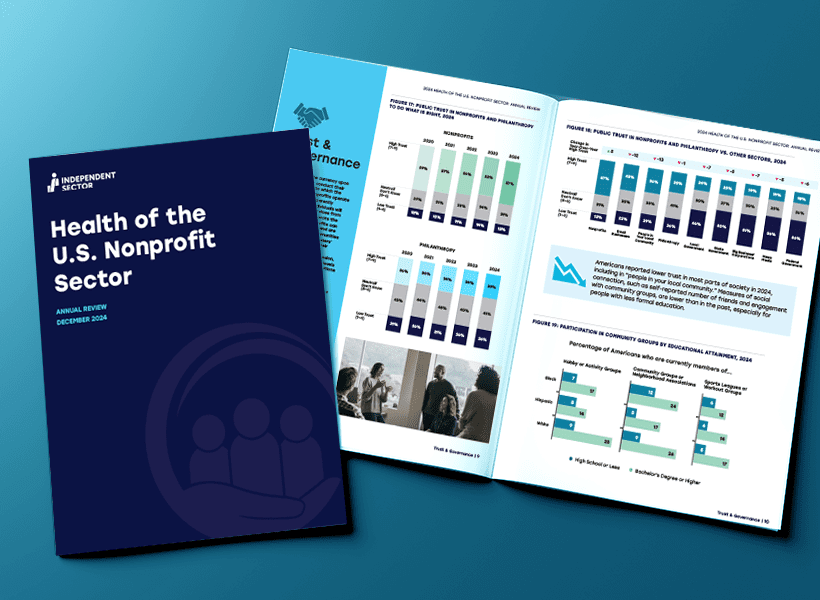Independent Sector’s most recent quarterly review of data on the health of the U.S. nonprofit sector demonstrates that despite economic uncertainty, the sector remains a critical driver of the national economy and workforce. The sector is living up to its reputation as resourceful “doers” that step up to the plate during times of need. Its economic contribution largely is holding steady, the total dollars donated in 2022 increased, and the sector finally crossed the important benchmark of employing the same number of jobs as before the pandemic. Unfortunately, all these positive indicators paper over cracks in the sector’s foundation that nonprofit leaders and policymakers cannot ignore.
Many in the sector are advancing their missions and achieving incredible outcomes, while also juggling a wide range of underlying challenges — specifically declining donors, understaffing, and a less diverse workforce. They are managing these challenges during an uncertain economic and policy environment, which makes it even more difficult to devise solutions to their problems. This dynamic creates significant pressure on organizations, donors, staff, and volunteers. Some nonprofit stakeholders may feel they are living the plot of the children’s book, The Good Egg, in which an egg is so busy helping others, it does not notice when it begins cracking under the pressure. Included below are some high-level summaries of the most recent quarterly data regarding the Health of the U.S. Nonprofit Sector.
Nonprofit Finances and the Economy
In The Good Egg, the egg celebrates its accomplishments as a “verrrryyyyy good egg.” Similarly, the most recent quarterly report about nonprofit finances and their contributions to the economy provide many reasons to celebrate. U.S. nonprofits comprised 5.6% of gross domestic product (GDP). Nonprofits’ percent of GDP typically varies between 5.5% and 5.7% of GDP, so the sector’s economic contribution is well within the norm. This indicator and others within the quarterly review show nonprofits’ economic contributions appear to be stable in the fourth quarter of 2022. However, it remains unclear whether the sector’s stable financial and economic health will continue — considering persistent economic uncertainty.
Policymakers hold the strong assumption that charitable giving and the financial health of nonprofits are closely tied to the state of the economy. Growth in gross value added by nonprofits (2.2%) slightly trailed GDP growth (2.7%) in the fourth quarter. Nonprofit gross value-added exceeded GDP growth in the first half of 2022, but the sector trailed GDP in the second half of the year. Although analyses of the 2008 recession showed nonprofits recovering quickly after an economic downturn, it remains unclear whether high inflation in 2022 created enough economic uncertainty to impact nonprofits.
The amount of dollars given to nonprofits as of the third quarter of 2022 is higher than the same time in 2021. Unfortunately, the number of donors and retention of donors declined. The number of donors giving all sizes of gifts declined, but the largest decline is among donors (-5.6%) that give $100 or less. The phenomenon of overall charitable giving increasing, while the number of donors declines, marks a return to trends predating the pandemic. According to the Fundraising Effectiveness Project (FEP), nonprofits struggled to acquire donors, particularly small donors, which contributed to the large decrease in donor numbers overall. For context, FEP noted the year-over-year drop partially can be attributed to an “extra-ordinarily strong” second quarter in 2021 when charities received significantly more small donations.
It is notable that nonprofits continue to make significant contributions to the economy during a period of high inflation with the prospect of a mild recession on the horizon. However, it remains likely that that same economic uncertainty is straining nonprofits’ bottom lines, particularly discouraging donations and foundation grantmaking. A recent article in The Chronicle of Philanthropy warns that economic and financial uncertainty on the part of donors, financial partners, and nonprofit leaders could significantly impact nonprofits going forward. The article states, “Many nonprofits and grant makers are preparing for a slowdown by protecting their bank assets, safeguarding their investments, or trying to keep workers from fleeing to more lucrative opportunities.” Private foundations’ grantmaking often follows the stock market. Quarterly health reports earlier in the year noted actions by the Federal Reserve in 2022 are slowing inflation rates. However, the Federal Reserve now must balance raising interest rates enough to keep lowering inflation (which remains higher than normal) against stabilizing the financial sector, in which some institutions are crumbling under recent pressure. Patrick Rooney, professor of economics and philanthropic studies at the Lilly Family School of Philanthropy at Indiana University said, “Uncertainty is the enemy of investment in the capitalistic sector, but it’s also the enemy of investment in the philanthropic sector.” Independent Sector’s research on trust in the nonprofit sector also shows financial uncertainty likely influences people’s trust in nonprofits, which in turn impacts their willingness to give, volunteer, and advocate.
A short-term opportunity to make it easier for people to donate during times of financial uncertainty may be reinstating the ability for all taxpayers to claim a charitable deduction for their gifts, thereby reducing the cost of giving for individual households. To better understand potential long-term solutions, Independent Sector’s 2023 research on trust in the sector will further explore the relationship between trust and economic uncertainty, often captured in variables such as income, education, and class.
Nonprofit Workforce
In The Good Egg story, the little egg complained that its exclusive focus on helping others, while ignoring its own needs, led to a feeling nonprofit staff often call “burnout.” The egg said, “Every night, I was exhausted. My head felt scrambled.” Nonprofit leaders say they are grappling with how pushing to contribute to the economy and meet community needs may be impacting their workforce, particularly as they balance work amid economic and caregiving pressure.
The biggest positive workforce headline is that the fourth quarter of 2022 marked when the nonprofit sector finally recovered enough jobs to reach pre-pandemic levels of employment. Unfortunately, the recovery isn’t even across the entire sector. The arts, entertainment, and recreation subsectors employ 29,073 fewer jobs compared to 2017. Religious, grantmaking, civic, and professional subsectors employ 102,772 fewer jobs than in 2017.
Despite the sector recovering the number of jobs nonprofits employed in 2017, the composition of the workforce does not look exactly as it did prior to the pandemic. In the fourth quarter of 2022, the overall level of racial and ethnic diversity in the sector slightly declined. The proportion of white workers (77.7%) is higher than pre-pandemic levels in the nonprofit sector (approximately 70%) and higher than the current percentage of white workers in the overall workforce. In general, the racial and ethnic proportions of the nonprofit workforce track with demographics of the broader workforce, except for Hispanic workers. The exact cause for the disparity for Hispanic workers is unclear and would benefit from further research. From a wage perspective, the proportion of workers earning over $75,000 outpaced the overall workforce. The highest fourth quarter increase in the nonprofit workforce is for employees earning $40,000 or less.
In The Chronicle of Philanthropy article about economic uncertainty, Paul Schervis, professor of sociology at the Boston College Center on Wealth and Philanthropy, predicts that financial or economic uncertainty may hit small nonprofits particularly hard, citing rising wages and challenges attracting and retaining talent make it even harder to manage budgets right now. Demand for better compensation and benefit supports for staff may combine with supply-side funding uncertainty in ways that Schervis warns could increase the number of mergers or closings of small nonprofits. “Just as there’s this clearing out of corporations and even banks at times, we might see a clearing out of nonprofits in the near future…We’re going to hear more about the difficulty for nonprofits to survive,” he says.
Other challenges related to recruitment and retention of a diverse workforce may include actions needed within organizations and broader systems. As described in an earlier quarterly report, insufficient infrastructure support, such as caregiving and childcare policies, may be a barrier to women, but particularly women of color, re-entering the workforce or staying in the sector. Within organizations, there are calls for nonprofits to place inclusion and belonging at the forefront of their recruitment and retention efforts, including “good pay, profession-development opportunities, an inclusive atmosphere, and reporting procedures for when problems arise.” However, there also may be a workplace cultural component where employees have little tolerance for organizations that they do not feel “walk the talk.”
At the conclusion of The Good Egg story, the egg learned to prioritize self-care just as much, if not more, than caring for others. Once the egg took time to fix its cracks due to overwhelming pressure, it was able to turn his attention back to helping others. Probably the more familiar analogy is the airline directive of putting an air mask on ourselves before helping others. Big questions remain on what it will take to build infrastructure, a financial environment, and nonprofit cultures to help our workforce thrive, so they in turn can help their communities do the same. Independent Sector is actively working with others to identify the answers to these questions, but we always could use more partners. If you are interested or have ideas on where the sector may need to focus first, please reach out to info@independentsector.org. We want to hear from you.
Updated as of November 27, 2023.



